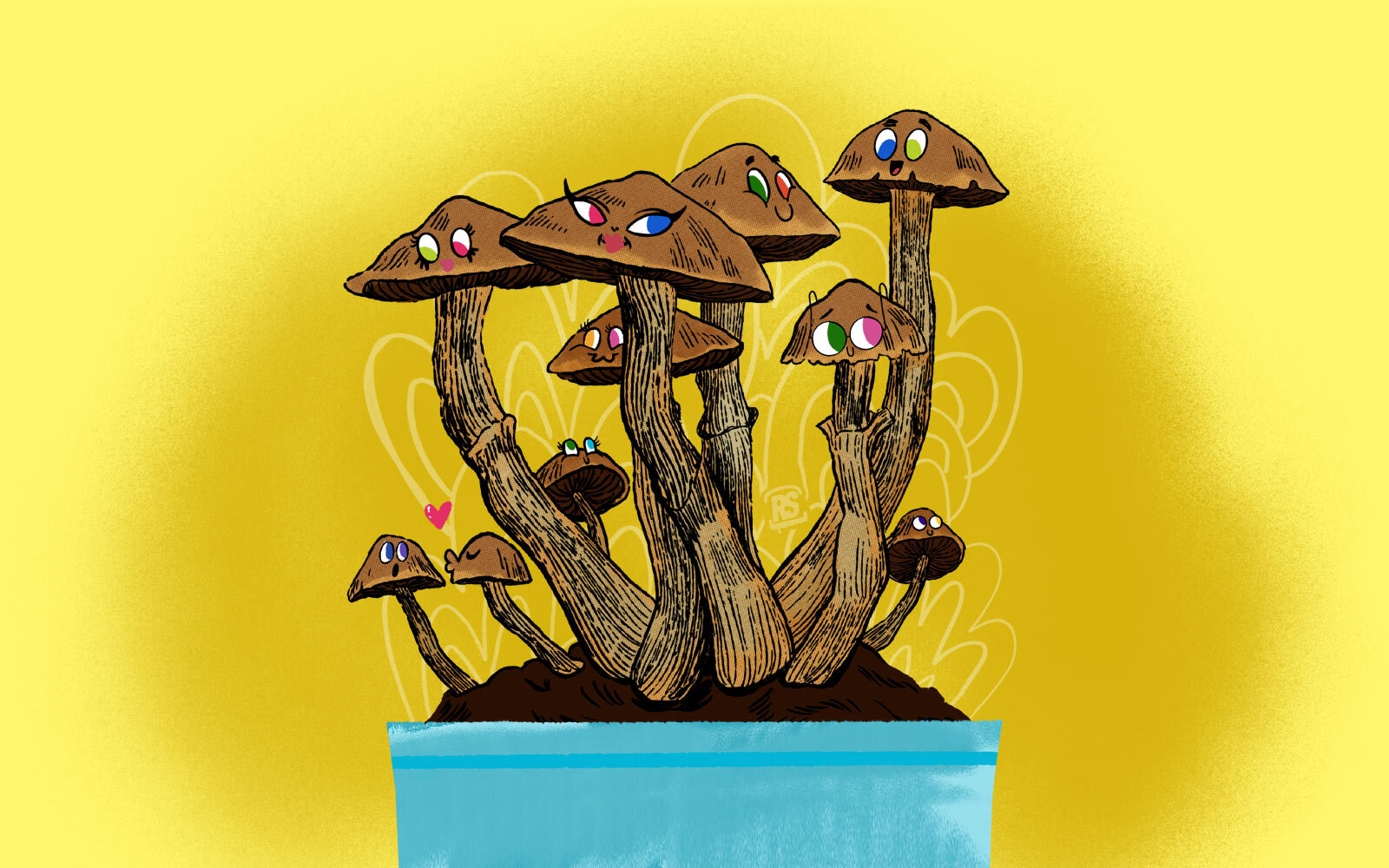Mushrooms have long been a source of mystery and magic in cultures around the world. From the culinary delights of the truffle to the hallucinogenic journeys offered by certain species, these fascinating fungi have woven themselves into the fabric of human history. Among the myriad of these intriguing organisms, the Psilocybe ovoideocystidiata is a shining star, particularly for those interested in the mind-altering experiences they provide.
Discovered in 2003 by mycologist Richard V. Gaines in Montgomery County, Pennsylvania, this relatively young species has quickly gained attention in the world of psychonauts and mycologists alike. The name might sound like a mouthful, but it gives hints to its unique characteristics. “Ovoideocystidiata” refers to its ovoid (egg-shaped) cystidia, a microscopic feature on the gills of the mushroom.
At a glance, it might resemble many other brown woodland mushrooms, but for those in the know, its unique characteristics, such as its gelatinous cap when wet and its preference for floodplain habitats, set it apart.
Belonging to the Psilocybe genus, this mushroom is part of a renowned group that boasts several psychedelic members. This genus, as highlighted by renowned mycologist Paul Stamets, is one of the most potent mushrooms and has been at the forefront of scientific research into the therapeutic potential of psychedelics.
Where to Find Psilocybe ovoideocystidiata
One of the mesmerizing aspects of mushroom hunting, or ‘foraging,’ is the detective work it requires. Not only do you need to know what a particular species looks like, but understanding its favored habitat is equally crucial. And for those on the hunt for Psilocybe ovoideocystidiata, this is particularly true.
Originating from the eastern United States, Psilocybe ovoideocystidiata has specific locales it calls home. As earlier mentioned, this particular species was first discovered in Montgomery County, Pennsylvania. But its reach isn’t limited to this region. Over the years, it’s been spotted in several states, notably Ohio, West Virginia, and even as far north as New Jersey.
So, what kind of backdrop sets the stage for this captivating mushroom to make its appearance? Psilocybe ovoideocystidiata has a penchant for woodlands — but not just any woodland. This mushroom has an affinity for riparian zones. These areas, often found alongside rivers, streams, and creeks, are hallmarked by frequent flooding.
The consistent moisture combined with the natural decay of plant material creates a haven for these mushrooms. Decomposing logs, especially from hardwood trees like beech and oak, become prime real estate for them. The often moss-laden, damp wood provides a nutrient-rich platform, allowing these shrooms to flourish.
Seasonality is another key factor for the eager forager. The best time to spot these elusive mushrooms is in the late spring to early summer, especially after a good rain. During this time, the ground is damp, the weather is warming, and the conditions are just right for them to sprout.

Psilocybe ovoideocystidiata Identification
Mycologists and foragers alike would attest: that correct identification is the heart of safe and effective mushroom harvesting. So, how does one identify Psilocybe ovoideocystidiata? Here are some key pointers:
Spores: Under the microscope, one would find that its spores are a rich purple-brown.
Cap: The cap is often 1.5 to 5 cm across, convex to flat, smooth, and gelatinous when wet, drying to a smoother texture. Its color can range from a rusty brown to a caramel hue, darkening as it matures.
Stems: As for the stems, they’re slender, ranging from 2 to 8 cm in length, often with a whitish to rusty-brown coloration. They may also feature a thin, white, gelatinous veil.
Lookalikes: Nature has its way of creating doppelgängers, and Psilocybe ovoideocystidiata is no exception. Beware of Galerina marginata, a deadly mushroom that can sometimes share its habitat. Knowledge and caution are essential!
Tips for Foraging Safely
Mushroom foraging can be an exhilarating activity, akin to a treasure hunt in nature’s vast expanse. However, the world of fungi is as diverse as it is mysterious, with some species bearing delightful secrets while others conceal deadly toxins. Navigating this world safely requires knowledge, preparation, and prudence. Here are some key tips to ensure your foraging expedition remains fruitful and safe:
- Buddy System: Always forage with a companion. Besides the added set of eyes, it ensures safety in numbers.
- Documentation: Keep a journal or a camera handy. Recording physical traits and growth conditions can aid in proper identification.
- Reference Field Guides: Carry reputable mushroom guides or mobile apps. When in unfamiliar territory, cross-referencing is invaluable.
- Know the Terrain: Some mushrooms prefer specific habitats. Understanding the terrain can enhance your success rate and safety.
- Touch with Caution: Some fungi can be irritants. Wear gloves or handle unknown species minimally.
- Avoid Consumption On-Site: Never eat a wild mushroom in the field. Proper identification often requires time, resources, and sometimes even expert consultation.
- Conservation: Remember, foraging is not just about taking. Practice sustainable harvesting, ensuring the ecosystem remains intact for future generations.
Armed with these tips and a healthy dose of respect for nature, your foraging adventures can be both rewarding and safe.
Psilocybe ovoideocystidiata Potency and Effects
For the intrepid psychonaut, understanding the potency and effects of a particular mushroom can be the key to a transcendent and safe journey. The Psilocybe ovoideocystidiata, with its intriguing origin and habitat, beckons with promises of psychedelic voyages. But what can one expect? Let’s explore the strength and the spectrum of effects this woodland shroom has to offer.
How Strong is Psilocybe ovoideocystidiata?
Psilocybe ovoideocystidiata holds its ground with respectable strength. Notably, while it may not rival the potency of giants like Psilocybe azurescens (Flying Saucers) or the well-known Psilocybe semilanceata (Liberty Cap), it surpasses many others in its psychoactive profile.
Its strength primarily stems from its content of psilocybin and psilocin, two naturally occurring psychedelic compounds. When consumed, these compounds are either metabolized or directly interact with the brain’s serotonin receptors, inducing altered states of consciousness. The resultant effect can be profound, even if the mushroom isn’t the most potent of its kind. Dosage, individual physiology, and environmental factors can all influence the intensity of the experience.
Effects of Psilocybe ovoideocystidiata
Engaging with Psilocybe ovoideocystidiata is like embarking on a multifaceted journey. Here’s what the ride might entail:
Visual Alterations: Many users report enhanced colors, vivid patterns, and morphing shapes. The world can appear more vibrant, and inanimate objects may seem to breathe or move.
Emotional Amplification: Feelings, whether of joy, sadness, or introspection, can be heightened. Moments of profound emotional clarity or even catharsis are possible.
Sense of Unity: A feeling of oneness with the universe, or a dissolution of the ego, is a hallmark of many psychedelic experiences, and this mushroom is no exception.
Temporal Distortion: Time may seem to stretch, with minutes feeling like hours, or vice-versa.
Enhanced Sensory Perception: Sounds can be sharper, touch more sensitive, and even taste can be more profound.
Cognitive Shifts: Thought processes might alter, leading to introspective insights, philosophical revelations, or a different perspective on past events.
It’s worth noting that while many find their journey with Psilocybe ovoideocystidiata enlightening, the experience is deeply personal. Set and setting play pivotal roles in shaping the trip. As with any psychedelic, approaching with intention, respect, and adequate preparation can make all the difference.
Growing Psilocybe ovoideocystidiata
Growing your mushrooms, whether for culinary, medicinal, or psychedelic purposes, can be a deeply rewarding endeavor. Cultivating Psilocybe ovoideocystidiata, the mysterious woodland shroom, in the comfort of your home may sound like a challenging feat given its natural habitat. However, with the right knowledge, tools, and a touch of patience, it’s a journey even novice mycologists can embark on. Here’s a guide to help you understand the nuances of growing this particular species.
Understanding Its Natural Habitat
To emulate the best growing conditions, it’s essential first to understand where Psilocybe ovoideocystidiata thrives. Naturally, it loves riparian zones—areas adjacent to rivers, streams, and creeks, where moisture is abundant. While your home might not be a babbling brook in a dense woodland, replicating the humidity and temperature of such an environment is key.
Substrate Selection
The substrate is essentially the ‘soil’ for mushrooms. Given that this magic mushroom prefers wood-based habitats in the wild, a mix of hardwood-based materials, like oak or beech wood chips, works best. Supplementing with straw can further enhance the substrate’s nutritional profile.
Sterilization
One of the most crucial steps in mushroom cultivation is sterilization. This ensures that contaminants, which can jeopardize your cultivation efforts, are eliminated. Autoclaving or pressure cooking your substrate before introducing the mushroom spores can achieve this.
Inoculation
Once the substrate is prepared and sterilized, it’s time for inoculation—introducing the mushroom spores to the substrate. This can be done using a spore syringe or grain-to-grain transfer if you’re working from a previously colonized substrate. Always ensure your workspace is clean to minimize contamination risk.
Incubation
After inoculation, the substrate needs to be kept in a warm, dark place to allow the mycelium (the root-like structure of fungi) to colonize the substrate. A temperature range of 75-80°F (24-27°C) is ideal. During this phase, which may last several weeks, you’re looking for a dense white network to cover the substrate. This is a sign that the mycelium is healthy and thriving.
Fruiting Conditions
Once fully colonized, it’s time to introduce your setup to fruiting conditions. This involves exposing the mycelium to fresh air, cooler temperatures (around 70°F or 21°C), and indirect light. This mimics the natural transition from underground growth to surface fruiting.
Harvesting
When the caps of the mushrooms fully uncurl but just before they start to flatten out, it’s harvest time. Gently twist and pull the mushroom from the substrate, ensuring you don’t leave behind any broken bits.

For the Enthusiasts: Grow Kits
For those not keen on starting from scratch, there are mushroom grow kits available. These kits often provide a simplified and streamlined process, ideal for beginners. If you’re interested, check out the Top 2023 Grow Kits Here.
Whether you start out with the mushrooms mentioned here or try your hand with varieties like Penis Envy, Cambodian, or Wavy Caps—we wish you a successful mycological journey and incredible psychedelic discoveries.













